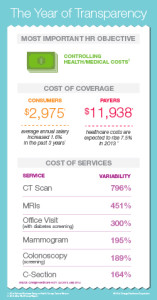 Yesterday kicked off this week in Health Populi, focusing on the growing role of transparency in health care in America. Today’s post discusses the results from Change Healthcare’s latest Healthcare Transparency Index report, based on data from the fourth quarter of 2013, published in May 2014.
Yesterday kicked off this week in Health Populi, focusing on the growing role of transparency in health care in America. Today’s post discusses the results from Change Healthcare’s latest Healthcare Transparency Index report, based on data from the fourth quarter of 2013, published in May 2014.
Charges for health services — dental, medical and pharmacy – varied by more than 300% in Q42013 — even within a single health network. Change Healthcare found this, based on their national data on 7 million health-covered lives. The company analyzed over 180 million medical claims. The company built the Healthcare Transparency Index (HCTI) to gauge cost and cost variability in health services over time. The chart illustrates a few of the HCTI findings: for example, that a CT scan on average cost $1,238, but can vary by nearly 800% (that’s 8x) on a patient by patient basis. A pediatric exam, which costs on average $55, can vary by 75% – while still double-digit, not nearly the variability of that high-end digital scan.
Another case in point is C-sections, for which there’s been a 60% increase since 1996 according to the National Center for Health Statistics. 1 in 3 women who gave birth in the U.S. in 2011 underwent a C-section. And the cost of C-sections varies as much as 164%, with a range of $6,680 to $17,619 in Q4 of 2013.
Don’t think that C-sections are the only birthing mode to have high cost variability: vaginal deliveries’ cost variability was 189%, ranging from $4,359 to $12,613.
Health Populi’s Hot Points: Employers and payors will continue to shift financial risk to enrollees, forcing them to flex consumer muscles. Without transparency of prices, availability of services, and quality, the market-building intentions of those payors will be elusive and lead to less-than-optimal outcomes — both physically and fiscally for patients.
Change Healthcare notes that 64% of large employers will offer consumer-directed health plans (high-deductible plans coupled with health savings accounts) in 2016. Today, millions of health-insured Americans are in these plans, fairly green to the concepts of meeting a deductible and managing a tax-advantaged HSA. These new-new plan types, called value-based and consumer-directed plans, will deliver neither value nor consumer-empowerment without transparency and tools to arm that evolving health consumer in her/his new role. Change Healthcare offers tools for cost look-ups, and more health plans have begun to do the same. The supply-side of health care must catch up to the demand/consumer side — which is the opportunity for new entrants in health care.
Tomorrow’s post on healthcare transparency will look at trends in health care payments for consumers, and tools to help people make those payments. More tools from new entrants will be covered on Thursday and Friday’s posts on this Season of Healthcare Transparency.




 I'm in amazing company here with other #digitalhealth innovators, thinkers and doers. Thank you to Cristian Cortez Fernandez and Zallud for this recognition; I'm grateful.
I'm in amazing company here with other #digitalhealth innovators, thinkers and doers. Thank you to Cristian Cortez Fernandez and Zallud for this recognition; I'm grateful. Jane was named as a member of the AHIP 2024 Advisory Board, joining some valued colleagues to prepare for the challenges and opportunities facing health plans, systems, and other industry stakeholders.
Jane was named as a member of the AHIP 2024 Advisory Board, joining some valued colleagues to prepare for the challenges and opportunities facing health plans, systems, and other industry stakeholders.  Join Jane at AHIP's annual meeting in Las Vegas: I'll be speaking, moderating a panel, and providing thought leadership on health consumers and bolstering equity, empowerment, and self-care.
Join Jane at AHIP's annual meeting in Las Vegas: I'll be speaking, moderating a panel, and providing thought leadership on health consumers and bolstering equity, empowerment, and self-care.